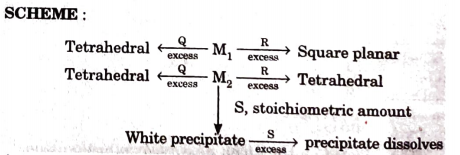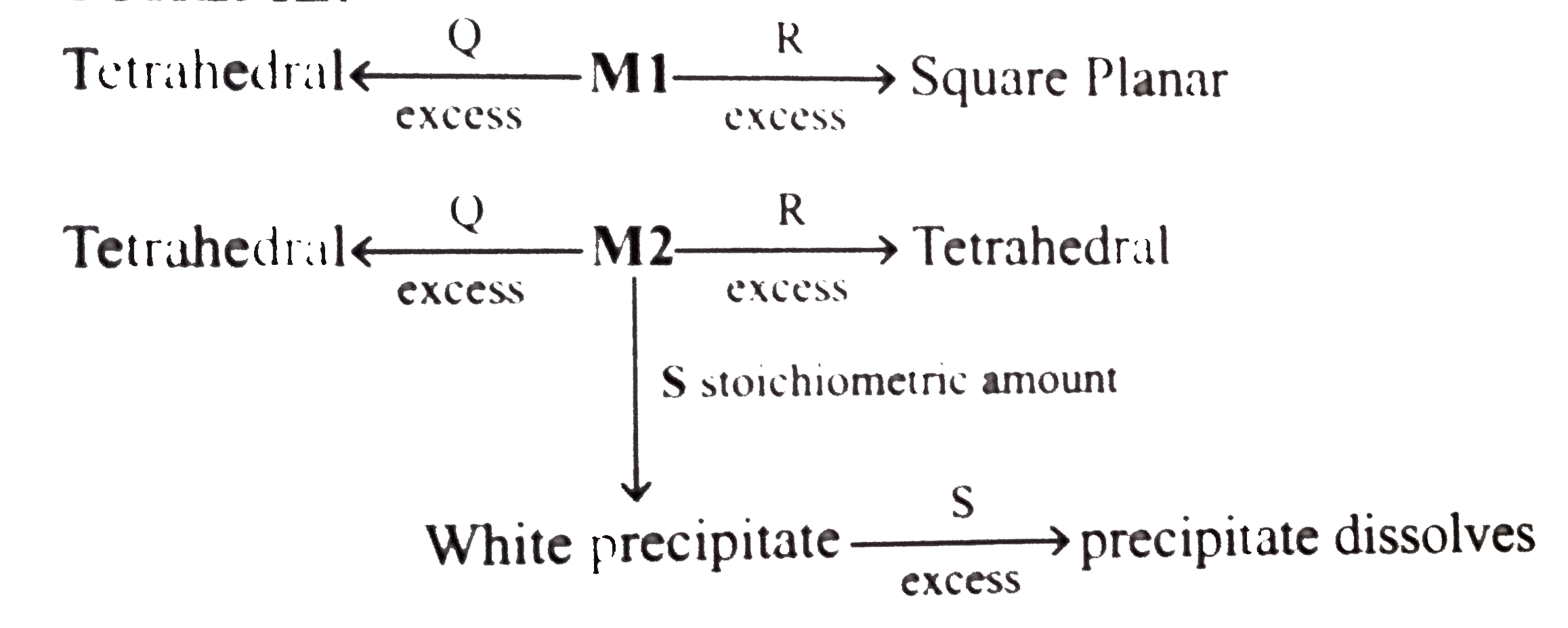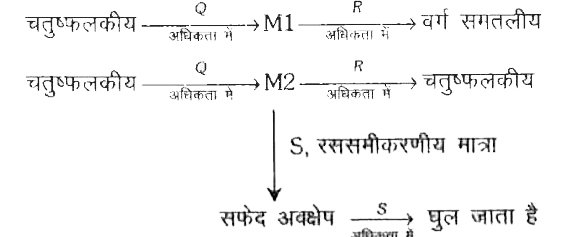An aqueous solution of metal ion M1 reacts separately with reagents QandR in excess to give tetrahedral and square planar complexes, respectively. An aqueous solution of another metal ion M2 always forms tetrahedral complexes with these reagents. Aqueous solution of M2 on reaction with reagent S gives white precipitate which dissolves in excess of S. The reactions are summarized in the scheme given below :
 M1,QandR, respectively are :Solution in Punjabi
M1,QandR, respectively are :Solution in Punjabi
Zn2+, KCN and HCl
Ni2+, HCl and KCN
Cd2+, KCN and HCl
KOH
Step by step video & image solution for An aqueous solution of metal ion M_1 reacts separately with reagents Q and R in excess to give tetrahedral and square planar complexes, respectively. An aqueous solution of another metal ion M_2 always forms tetrahedral complexes with these reagents. Aqueous solution of M_2 on reaction with reagent S gives white precipitate which dissolves in excess of S. The reactions are summarized in the scheme given below : M1, Q and R, respectively are : by Chemistry experts to help you in doubts & scoring excellent marks in Class 12 exams.
Updated on:21/07/2023Topper's Solved these Questions
- COORDINATION COMPOUNDSBOOK - MODERN PUBLICATIONCHAPTER - COORDINATION COMPOUNDSEXERCISE - EXERCISE
971 Videos
- CHEMISTRY IN EVERYDAY LIFEBOOK - MODERN PUBLICATIONCHAPTER - CHEMISTRY IN EVERYDAY LIFEEXERCISE - EXERCISE
352 Videos
- d-AND f- BLOCK ELEMENTSBOOK - MODERN PUBLICATIONCHAPTER - d-AND f- BLOCK ELEMENTSEXERCISE - EXERCISE
1089 Videos
Similar Questions
What is the coordinate number of the central metal ions in the following coordination compound ?
[PtCl2(en)2]
View SolutionTrue or False : Equanil, used as tranquilizer, is a derivative of barbituric acid.
View SolutionName the third and fourth transition elements of first transition series.
View SolutionAn aqueous solution of metal ion MI reacts separately with reagents Q and R in excess to give tetrahedral and square planar complexes, respectively An aqueous solution of another metal ion M2 always forms tetrahedral complexs with theses reagents. Aqueous solution of M2 on reaction with reagent S gives white precipitate which dissolves in excess of S The reactions are summarised in the scheme given below: SCHEME :

View SolutionAn aqueous solution of metal ion MI reacts separately with reagents Q and R in excess to give tetrahedral and square planar complexes, respectively An aqueous solution of another metal ion M2 always forms tetrahedral complexs with theses reagents. Aqueous solution of M2 on reaction with reagent S gives white precipitate which dissolves in excess of S The reactions are summarised in the scheme given below: SCHEME :
View SolutionAn aqueous solution of a metal ion (A) on reaction with Kl gives a black brownish ppt (B) and this aqueous suspension on treatment with excess Kl gives orange yellowish solution. Then A is
View SolutionAn aqueous solution of metal ion M_(1) reacts separately with reagents Q and R in excess to gie tetrahedral and sqaure planar complexes, respectively. An aqueous solution of another metal ion M_(2) always forms tetrahedral complexes with these reagents. Aqueous solution of M_(2) on reaction with reagent S gives white precipitate which dissolves in excess of S. The reaction are summarised in the scheme given below Scheme M_(1), Q and R, respectively are
View SolutionAn aqueous solution of metal ion M_(1) reacts separately with reagents Q and R in excess to gie tetrahedral and sqaure planar complexes, respectively. An aqueous solution of another metal ion M_(2) always forms tetrahedral complexes with these reagents. Aqueous solution of M_(2) on reaction with reagent S gives white precipitate which dissolves in excess of S. The reaction are summarised in the scheme given below Scheme Reagent S is
View SolutionAn aqueous solution of metal ion M1 reacts separately with reagents Q and R in excess to give tetrahedral and square planar complexes, respectively. An aqueous solution of anotherr metal ion M2 always forms tetrahedral complex with these reagents. Aqueous solution of M2 on reaction with reagent S gives white precipitate which dissolves in excess of S. The reactions are summarized in the scheme given ahead.
SCHEME:
Tetrahedral Q←−−excessM1R−−→excess Square planar
TetrahedralQ←−−excessM2R−−→excessTetrahedral ↓S.stoichiometric amount White pptS−−→excess.Precipitate dissolves
M1,Q and R, respectively are:
View SolutionAn aqueous solution of metal ion M_(1) reacts separately with reagents Q and R in excess to give tetrahedral and square planar complexes, respectively. An aqueous solution of anotherr metal ion M_(2) always forms tetrahedral complex with these reagents. Aqueous solution of M_(2) on reaction with reagent S gives white precipitate which dissolves in excess of S. The reactions are summarized in the scheme given ahead. SCHEME: Tetrahedral overset(Q)underset("excess")larr M_(1)overset(R)underset("excess")rarr Square planar {:("Tetrahedral"overset(Q)underset("excess")larrM_(2)overset(R)underset("excess")rarr"Tetrahedral"),(" "darrS."stoichiometric amount"),(" ""White ppt" overset(S)underset("excess")rarr."Precipitate dissolves"):} Reagent S is:
View SolutionIn Aqueous solution, metal ion M_(1) reacts separately with reagents Q and R in excess to give tetrahedral and square planar complexes respectively. An aqueous solution of another metal ion M_(2) always froms tetrahedral complexes with these reagents. Aqueous solution of M_(2) on reaction with reagent S gives white precipitate which dissolves in excess of S. The reactions are summarized in the scheme given ahead M_(1) , Q and R respectively are
View SolutionIn Aqueous solution, metal ion M_(1) reacts separately with reagents Q and R in excess to give tetrahedral and square planar complexes respectively. An aqueous solution of another metal ion M_(2) always froms tetrahedral complexes with these reagents. Aqueous solution of M_(2) on reaction with reagent S gives white precipitate which dissolves in excess of S. The reactions are summarized in the scheme given ahead Reagent S is
View SolutionWhich of the following aqueous solution of cation(s) give(s) white ppt. with NaOH and NH4OH solution and formed ppt. is/are further completely dissolve din one of the excess reagent?
View SolutionAqueous solution of a colorless metal sulfate gives white precipitate with NaOH, which dissolves in excess of NaOH. In this solution H_(2)S If there is a white precipitate when flowing, the metal in the salt will be M
View SolutionPassage - IV
एक धातु आयन M1 का जलीय विलयन अलग-अलग Q तथा R अभिकर्मकों की अधिकता में अभिक्रिया करके क्रमशः चतुष्फलकीय एवं वर्ग समतलीय संकुल बनाते हैं। दूसरे धातु आयन M2 का जलीय विलयन दोनों अभिकर्मकों के साथ अभिक्रिया करके हमेशा चतुष्फलकीय संकुल बनाता है। M2 का जलीय विलयन अभिकर्मक S से अभिक्रिया करके सफेद अवक्षेप देता है जो S की अधिकता में घुल जाता है। अभिक्रियाएँ नीचे दी गई योजना में दर्शायी गई है।

M1, Qऔर R क्रमशः हैं।
View SolutionPassage - IV
एक धातु आयन M1 का जलीय विलयन अलग-अलग Q तथा R अभिकर्मकों की अधिकता में अभिक्रिया करके क्रमशः चतुष्फलकीय एवं वर्ग समतलीय संकुल बनाते हैं। दूसरे धातु आयन M2 का जलीय विलयन दोनों अभिकर्मकों के साथ अभिक्रिया करके हमेशा चतुष्फलकीय संकुल बनाता है। M2 का जलीय विलयन अभिकर्मक S से अभिक्रिया करके सफेद अवक्षेप देता है जो S की अधिकता में घुल जाता है। अभिक्रियाएँ नीचे दी गई योजना में दर्शायी गई है।

M1, Qऔर R क्रमशः हैं।
View Solution
